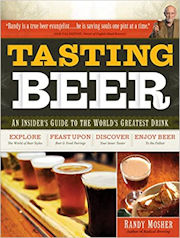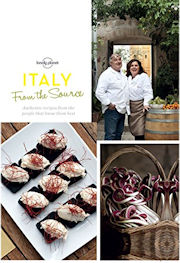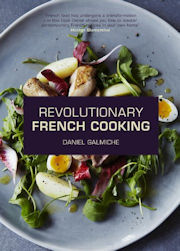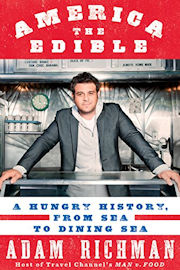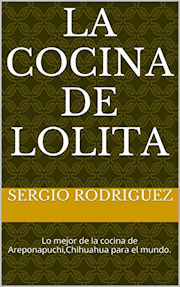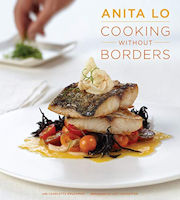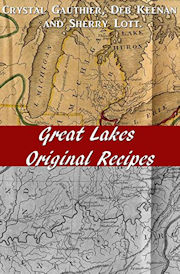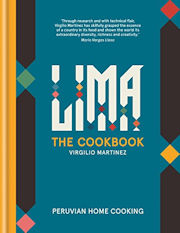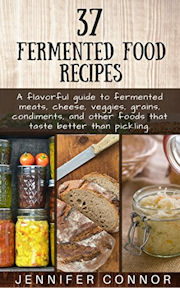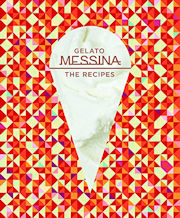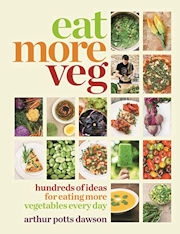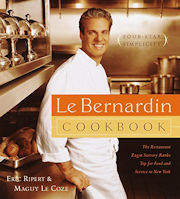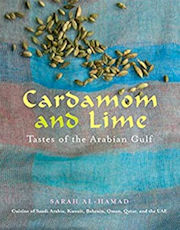It’s been awhile since I’ve done a book round-up. I’ve more or less kept up with non-food related books over on my personal website, but haven’t put any time into pimping out those related to food and drink here. Let’s hope this isn’t too overwhelming…just a “baker’s dozen” in the order I read through them (there are also some that are slowly in the works, like Nathan Myhrvold’s massive Modernist Cooking boxed set with its mere 2,438 pages of dense, technical detail).
Tasting Beer: An Insider’s Guide to the World’s Greatest Drink by Randy Mosher – An in-depth look at the history of beer brewing, from earliest recorded examples on through to the modern microbrewery movement. The book, at times, gets a bit technical, but that’s part of what it’s there for. Of most interest is the detailed review of the various styles of beer and not only how they’re produced, but what they should taste like, and recommended examples of each to try. Also a great introduction to the “tasting language” of beer, which is far different from that of wine, which I’m more familiar with. Definitely recommended for anyone who wants to learn more about beer.
From the Source – Italy: Italy’s Most Authentic Recipes From the People That Know Them Best from Lonely Planet – Primarily this is “just” a recipe book. There’s not a lot of explanatory text, nor narrative. The editors from Lonely Planet basically sat down with various chefs, well known within Italy, if not outside, as masters of particular regional cuisines. The book includes some of the most interesting sounding recipes that I’ve seen in an Italian cookbook, many of which I’d never even heard of before. For someone who wants to cook, and try new things in the Italian canon, this book is an absolute must. It’s not a book to sit down and read, particularly, but more to prop up in the kitchen and get to work.
Revolutionary French Cooking by Daniel Galmiche – Interesting recipes, some, though not all of them, with twists on classic and modern French and fusion cooking. Revolutionary? Not so much – most of what’s here is rather similar to any of many other modern French cookery books with global influences. And, although each recipe is introduced with a small blurb about its inspiration, those intros don’t feel all that personal, but rather like someone (an editor?) told him he had to come up with two sentences about where the recipe came from.
America the Edible: A Hungry History, from Sea to Dining Sea by Adam Richman – One of the things that I particularly don’t like to do when I’m writing is anything that requires that I review a restaurant or book created by someone I know, especially someone whom I like. Thankfully, in the case of Adam Richman’s slightly rambling epic as he crisscrosses the country, dining out on local specialties, this is a rolicking fun read. While I mostly know him from his show of excess, Man vs. Food, and a touch from his other television productions, I’ve also gotten to spend a day with him while filming in my own restaurant, and hey, we’re friends on Facebook, so there. This book is pure him. If you love his style on television (which I do), you’ll love it here (which I did). Perhaps a little “TMI” on the women in his life history, but that’s just part of the story.
La Cocina de Lolita: Lo mejor de la cocina de Areponapuchi, Chihuahua para el mundo by Sergio Rodriguez – (I should probably review this in Spanish, but, hey, the rest of the blog is in English….) I have to admit, I wanted to like this a lot more than I did. There’s just little substance to it that makes for interesting reading. It’s basically just a page by page collection of recipes from a particular place in Mexico, with little to no explanation, nothing to grab your attention and say why you might want to cook a particular dish. Honestly, the author could have stuck the recipes on a bunch of 3×5 cards and sent them out in a packet and it would have been more useful.
Cooking Without Borders by Anita Lo & Charlotte Druckman – Anita and I go way back. Like, way back. Late 80s/Early 90s, I don’t recall exactly. We met under somewhat bizarre circumstances. I was working as the chef at The Kitchen Club in Manhattan. I got a call from the owner of a nearby restaurant, who asked if I’d be interested in interviewing to be the chef there and decided to give it a shot. The interview consisted mostly of being thrown into her kitchen and told to come up with a three course meal for four in under an hour from whatever I found in the pantry. I got the job. Almost a 50% increase in my salary. Better hours. I gave two weeks’ notice. A week later, I got a call from Anita Lo. She told me that she’d just taken a job as chef at a nearby restaurant, and when she asked the owner about hiring a sous-chef, the owner suggested me. Guess which restaurant? I called the owner, she told me she decided she couldn’t wait the two weeks until I left where I was (and not tell me about it), so she’d decided to hire someone else, and I could take the sous chef job (at lower pay than I was currently making) or not bother her again. Needless to say, I didn’t take it, but relayed the story to Anita (who I don’t think believed me at the time). Over the years, we became, while not fast friends, certainly friendly, and I’ve always loved eating at her own restaurant (opened down the road, I think she only stayed at that ill fated place a few months), Anissa.
All that said, I was looking forward to reading her book, and it’s chockful of all the stuff I love about her cooking and her personality. Great stories, beautiful photos, intelligent recipes. Just what you want from a top chef’s cookbook and memoir.
Great Lakes Original Recipes by Deb Keenan, Crystal Gauthier, Sherry Lott – This one just caught my attention because it’s from the area where I grew up. It’s more or less one of those collections that church or synagogue ladies put together as a fundraiser, often on cards that are held together by a couple of rings, or a quick and easy plastic spiral bound and xeroxed manifesto. So it’s nice to see a similar sort of collection done in true book form. For anyone who grew up in the area, it’s a nostalgic trip through childhood food memories – some of them good, some of them not so good. It’s a more recent collection, and there’s clearly a more international influence on the recipes than that of my childhood era, but the elements are still recognizable. It could use a little proofreading and a bit of editorial consistency, but that’s almost to be expected from the genre.
Lima the cookbook by Virgilio Martinez – I’ve only met Virgilio in passing as the wine director of his acclaimed restaurant Central, in Lima, is a friend of mine. This book is not based on the modernist style cuisine of that restaurant, but rather on that of his duo of restaurants called Lima, both in London. It’s a more casual, accessible style of cooking, particularly for home cooks. I love that it makes use of the indigenous ingredients of Peru, but shows how to work with them in ways that any good home cook should find relatively easy to do. Some great recipe and ingredient combination ideas. It’s not particularly a “read”, as it’s about 90% recipes, and I’d have liked more narrative about how these ideas came about, and the exploration of the ingredients, but, so be it, “the cookbook” is right in the title.
37 Fermented Food Recipes: A flavorful guide to fermented meats, cheese, veggies, grains, condiments, and other foods that taste better than pickling by Jennifer Connor – There’s more useful information in the title of the book than there is inside. Waste of time. Poorly thought out recipes, some of which make no sense at all, badly written/proofread with numerous spelling and grammar mistakes on virtually every page. This feels like a book that someone sat down to write before having their coffee in the morning, pounded out, didn’t bother to read back through it, and just posted it as an ebook.
Gelato Messina: The recipes by Nick Palumbo – I suppose I should have been surprised. The title says it right there, this book is the recipes. And pretty much nothing else. A little bit on equipment and ingredients at the beginning, but basically it’s just dive in and page after page of recipes. Given that they’re all ice creams, it’s a bit repetitive. No, strike that, it’s a lot repetitive. Not only are there dozens of recipes that are pretty much identical other than one or two flavoring ingredients, but the author basically cut and pasted the ingredient lists and the instructions one after another, right down to the different techniques for different types of ice cream making equipment. So I thought, okay, this must be a companion volume to, say, Gelato Messina: The story. But as best I can tell, it’s not. There’s another recipe book, called Gelato Messina: The creative department, which takes all these various ice cream recipes (I’m guessing) and turns them into works of art – that book is touted as a coffee table book for anyone who’s not a professional pastry chef. Unfortunately, that means that there’s not much here you can’t get from a quick search on the internet for a decent ice cream recipe in the flavor you want. Meh.
Eat More Veg: Hundreds of ideas for eating more vegetables every day by Arthur Potts Dawson – As a recipe collection, this is interesting, and there are plenty of recipes to choose from. They virtually all sound delicious. But as a book to read, it’s, well, unfortunately, a bore. There’s just no soul to it, and the only thing personal about it is intro sentences to many of the recipes that basically state some variation of, “I cooked this one a lot when I worked at ___”. If you just want a reference, to look up an idea or two to cook something from one or another vegetables you have on hand, this is a great resource. If you’re looking for something to read, leave it on the shelf.
Le Bernardin Cookbook: Four-Star Simplicity by Eric Ripert & Maguy Le Coze – Nope, I’m not going to say I know chef Ripert, making this one a tough review. To the best of my knowledge, I’ve not met him, not really. I was at a table in his restaurant with some other wine and food folk once and he came over to say hello to one of the people at the table and did a sort of broad nod and hello to the rest of us, and I’ve known cooks and sommeliers who worked there, that’s as close as I get. I love Le Bernardin. I love it more when someone takes me there, because it’s been out of reach of my wallet for most of my career. It’s a delight to read the story behind the place, particularly that of the Le Coze siblings and how the restaurant came to be, people often forget that Le Bernardin wasn’t created by Ripert, although it certainly achieved its lofty status under him. The recipes are easy to read, accompanied by great stories of how they came to be – this is a cookbook written by and for people with a passion for food and cooking. They probably could have edited out a few of the dozens of “This is my favorite recipe in the world” comments from Maguy Le Coze, but then again, maybe they all really are.
Cardamom and Lime: Recipes from the Arabian Gulf by Sarah Al-Hamad – I came to this book as part of my Bread & Soup Project – I was looking for recipes for the most recent entry, Bahrain. It seems like there are only two English language books out there that focus on Arabian Gulf cuisine, and the other one was only available in a very expensive paperback ($78), so wasn’t an option. This is a beautifully photographed and well written introduction to the flavors of the region, with mouthwatering sounding, easy to follow recipes. I look forward to trying many of them out (unfortunately, it didn’t have recipes for my project, but them’s the breaks) and am happy to have it as an addition to my electronic book shelf – it’ll come in handy down the line for some of the other project entries, as well as just when I want to try cooking something outside of my usual repertoire.
